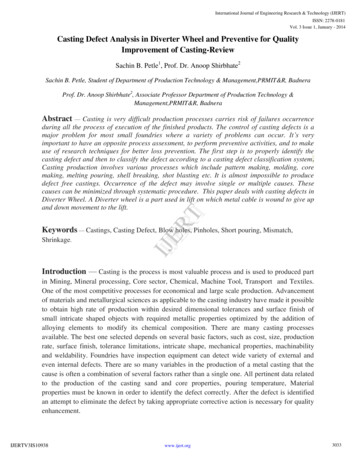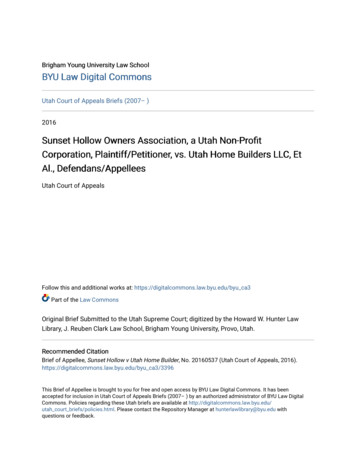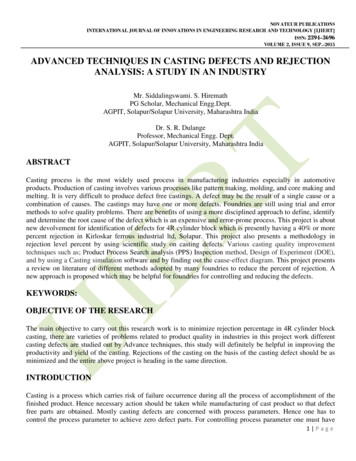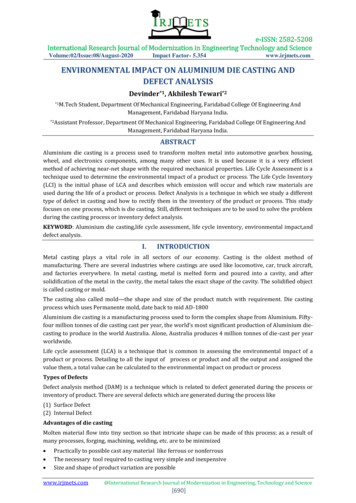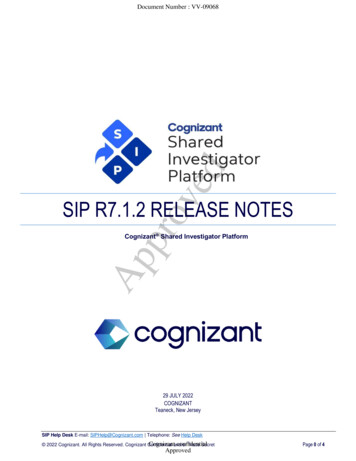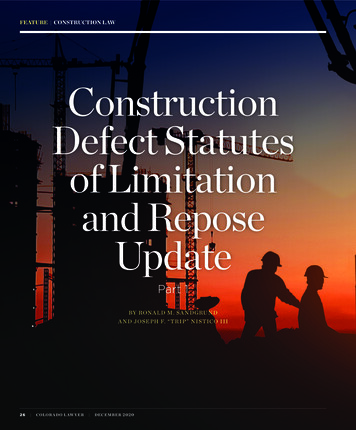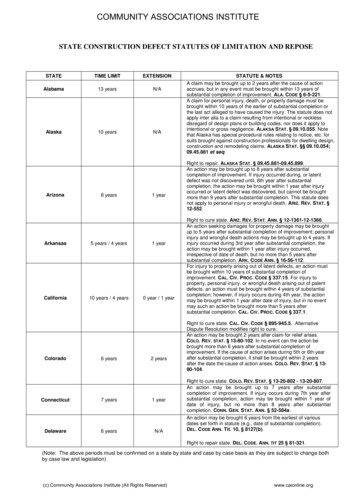
Transcription
COMMUNITY ASSOCIATIONS INSTITUTESTATE CONSTRUCTION DEFECT STATUTES OF LIMITATION AND REPOSESTATETIME LIMITEXTENSIONAlabama13 yearsN/AAlaska10 yearsN/AArizona8 years1 yearArkansas5 years / 4 years1 yearCalifornia10 years / 4 years0 year / 1 yearColoradoConnecticutDelaware6 years7 years6 years2 years1 yearN/ASTATUTE & NOTESA claim may be brought up to 2 years after the cause of actionaccrues, but in any event must be brought within 13 years ofsubstantial completion of improvement. ALA. CODE § 6-5-221.A claim for personal injury, death, or property damage must bebrought within 10 years of the earlier of substantial completion orthe last act alleged to have caused the injury. The statute does notapply inter alia to a claim resulting from intentional or recklessdisregard of design plans or building codes, nor does it apply tointentional or gross negligence. ALAKSA STAT. § 09.10.055. Notethat Alaska has special procedural rules relating to notice, etc. forsuits brought against construction professionals for dwelling design,construction and remodeling claims. ALASKA STAT. §§ 09.10.054;09.45.881 et seq.Right to repair. ALASKA STAT. § 09.45.881-09.45.899.An action may be brought up to 8 years after substantialcompletion of improvement. If injury occurred during, or latentdefect was not discovered until, 8th year after substantialcompletion, the action may be brought within 1 year after injuryoccurred or latent defect was discovered, but cannot be broughtmore than 9 years after substantial completion. This statute doesnot apply to personal injury or wrongful death. ARIZ. REV. STAT. §12-552.Right to cure state. ARIZ. REV. STAT. ANN. § 12-1361-12-1366.An action seeking damages for property damage may be broughtup to 5 years after substantial completion of improvement; personalinjury and wrongful death actions may be brought up to 4 years. Ifinjury occurred during 3rd year after substantial completion, theaction may be brought within 1 year after injury occurred,irrespective of date of death, but no more than 5 years aftersubstantial completion. ARK. CODE ANN. § 16-56-112.For injury to property arising out of latent defects, an action mustbe brought within 10 years of substantial completion ofimprovement. CAL. CIV. PROC. CODE § 337.15. For injury toproperty, personal injury, or wrongful death arising out of patentdefects, an action must be brought within 4 years of substantialcompletion; however, if injury occurs during 4th year, the actionmay be brought within 1 year after date of injury, but in no eventmay such an action be brought more than 5 years aftersubstantial completion. CAL. CIV. PROC. CODE § 337.1.Right to cure state. CAL. CIV. CODE § 895-945.5. AlternativeDispute Resolution modifies right to cure.An action may be brought 2 years after claim for relief arises.COLO. REV. STAT. § 13-80-102. In no event can the action bebrought more than 6 years after substantial completion ofimprovement. If the cause of action arises during 5th or 6th yearafter substantial completion, it shall be brought within 2 yearsafter the date the cause of action arises. COLO. REV. STAT. § 1380-104.Right to cure state. COLO. REV. STAT. § 13-20-802 - 13-20-807.An action may be brought up to 7 years after substantialcompletion of improvement. If injury occurs during 7th year aftersubstantial completion, action may be brought within 1 year ofdate of injury, but no more than 8 years after substantialcompletion. CONN. GEN. STAT. ANN. § 52-584a.An action may be brought 6 years from the earliest of variousdates set forth in statute (e.g., date of substantial completion).DEL. CODE ANN. Tit. 10, § 8127(b).Right to repair state. DEL. CODE. ANN. TIT 25 § 81-321.(Note: The above periods must be confirmed on a state by state and case by case basis as they are subject to change bothby case law and legislation)(c) Community Associations Institute (All Rights Reserved)www.caionline.org
COMMUNITY ASSOCIATIONS INSTITUTESTATE CONSTRUCTION DEFECT STATUTES OF LIMITATION AND REPOSESTATETIME LIMITEXTENSIONDistrict ofColumbia10 yearsN/AFlorida10 yearsN/AGeorgiaHawaii8 years10 years2 yearsN/ASTATUTE & NOTESActions for personal injury, property damage, or wrongful deathcaused by defective improvements to real property must bebrought within 10 years after substantial completion. D.C. CODEANN. § 12310.An action must be brought within 4 years of the latest of variouslisted dates (e.g., actual possession by owner, abandonment ofconstruction, etc.), except in cases of latent defects where 4 yearperiod begins to run from the time defect is discovered or shouldhave been discovered. An action must be commenced within 10years of latest of various listed dates. FLA. STAT. § 95.11(3)(c).Right to cure state. FLA. STAT. § 558.001 – 558.005.An action must be brought within 8 years of substantialcompletion to recover damages for personal injury, propertydamage, or wrongful death. If injury occurs in the 7th or 8thyear, an action in tort to recover damages for personal injury orwrongful death may be brought within 2 years, but in no eventmay an action be brought more than 10 years after substantialcompletion. GA. CODE ANN. § 9-3-51.Right to repair state. GA. CODE ANN. § 8-2-35 – 8-2-41.An action must be brought 2 years after accrual, but, in any event,not more than 10 years after the date of completion of theimprovement to real property. HAW. REV. STAT. § 657-8.Right to cure state. Haw. Rev. Stat. § 672E-1 – 672E-13.Mandatory mediation.Idaho6 years, plus statuteoflimitationN/AIllinois10 years4 yearsIndiana10 years / 12 years2 years / 2 yearsIowa15 yearsN/AKansas10 yearsN/ATort actions, if not previously accrued, shall accrue and applicablelimitation statute shall begin to run 6 years after final completion ofconstruction of an improvement. Contract actions shall accrue andthe applicable limitations statute shall being to run at the time offinal completion of construction of such improvements. IDAHOCODE § 5-241. The statute of limitations for a Contract action is 5years. IDAHO CODE § 5-216.Right to cure state. IDAHO CODE ANN. § 6-2501 – 62504)An action based in tort, contract, or otherwise may becommenced within 4 years from the time the plaintiff knew orshould have known of the act or omission complained of. Noaction can be brought after 10 years from the time of such act oromission, but if act or omission is discovered prior to theexpiration of 10 years the plaintiff shall have 4 years to bring hisaction. 735 ILL. COMP. STAT. 5/13214.An action to recover damages for property damage, personal injury,or wrongful death may be brought within the earlier of 10 yearsafter substantial completion or 12 years after the completion andsubmission of plans to the owner if the action is for a design defect.IND. CODE ANN. § 32-30-1-6.Right to cure state. IND. CODE § 32-27-3-1 – 32-27-3-14An action arising out of the unsafe or defective condition ofimprovement based on tort, implied warranty, and for contributionand indemnity, and based on injury to property, personal injury orwrongful death, may be brought up to 15 years from date of act oromission giving rise to action. IOWA CODE ANN. § 614.1(11).An action for injury to the rights of another, not arising on contract,and not otherwise enumerated by statute, is subject to a two yearstatute of limitations (Kansas has no specific provision regardingconstruction contracts). The action must be commenced within 10years of the act giving rise to the cause of action. KAN. STAT.ANN. § 60-513.Right to cure state. KAN. STAT. ANN. § 60-4701 – 60-4710.(Note: the above periods must be confirmed on a state by state and case by case basis as they are subject to change byboth case law and litigation.)(c) Community Associations Institute (All Rights Reserved)www.caionline.org
COMMUNITY ASSOCIATIONS INSTITUTESTATE CONSTRUCTION DEFECT STATUTES OF LIMITATION AND REPOSESTATETIME LIMITEXTENSIONKentucky5 yearsN/ALouisiana5 years / 10 years1 year / 0 yearsMaine10 yearsN/AMaryland10 years / 20 yearsN/AMassachusetts6 yearsN/AMichigan10 yearsN/AMinnesota10 years2 yearsMississippiMissouri6 years10 yearsN/AN/ASTATUTE & NOTESAn action for personal injuries brought against a builder of a home(or of other improvements) must be brought within 5 years of theoriginal occupancy of improvements. KY. REV. STAT. ANN. §413.120(14).Right to cure state. KY. REV. STAT. ANN. § 411-250 – 411.266.An action in contract, tort, or otherwise may be brought within 5years after the date of registry in mortgage office of acceptance ofwork by owner or, if acceptance is not recorded within 6 months ofoccupation/possession, 5 years after improvement is so occupied.LA. REV. STAT. ANN. § 9:2772(A). If injury occurs during the 5thyear after the date set forth under section A, action may bebrought within 1 year after date of injury, but no more than 6 yearsafter date set forth in section A. LA. REV. STAT. ANN. § 9:2772(C).An action against a contractor or an architect on account ofdefects of construction, renovation or repair of building and otherworks is subject to a liberative 10 year limitation. LA. CIV. CODEANN. ART. 3500.Right to repair. LA. REV. STAT. ANN. § 9:3141 – 9:31350.Applies only to “design professionals.” An action for professionalnegligence against architects/engineers must be brought within 4years of discovery of negligence, but no more than 10 years fromsubstantial completion of construction contract or, if no contract, 10years from substantial completion of services provided. ME. REV.STAT. ANN. Tit. 14, § 752-A. See also Montgomery v Rogers, 2000Me. Super. LEXIS191 (Me. Super. CT. Jan 24, 2000).An action must be brought within 3 years of injury. If the defendantis an architect, professional engineer, or contractor, the action maynot be brought if the injury occurs more than 10 years after theentire improvement became available. In all other cases, actionmay not be brought more than 20 years after entire improvementbecame available. MD. CODE ANN., CTS. & JUD. PROC. § 5-108.An action must be brought 3 years from accrual, but in no eventmore than 6 years after earlier of opening of improvement to useor substantial completion of improvement and owner’s taking ofpossession for occupancy. MA. GEN. LAWS ch. 260, § 2B.No action may be brought against a state licensed architect,professional engineer, or contractor more than 6 years afteroccupancy, use, or acceptance of improvement, or 1 year afterdefect is discovered or should have been discovered, providedthe defect is the proximate cause of injury/damage and is theresult of the defendant’s gross negligence. No action may bemaintained more than 10 years after the time of occupancy, use,or acceptance of improvement. MICH. COMP. LAWS ANN. §600.5839.An action must be brought 2 years from discovery of injury, but inno event more than 10 years after substantial completion ofconstruction. If action accrues during 9th or 10th year aftersubstantial completion, action may be brought up to 2 years afteraccrual, but no more than 12 years after substantial completion.MIN. STAT. § 541.051.Right to repair. MINN. STAT. ANN. § 327A.01 – 327A.08.No action may be brought more than 6 years after owner’s writtenacceptance, actual occupancy, or use of improvement, whicheveroccurs first. The statute does not apply to wrongful death. MISS.CODE ANN. § 15-1-41.Right to repair. MISS. CODE. ANN. § 83-58-1 – 83-58-17.An action may be brought up to 10 years from the completion ofimprovement. The statute is only applicable to persons whosesole connection with the improvement is performing or furnishing,in whole or in part, the design, planning or construction of theimprovement. MO. ANN. STAT. § 516.097.(Note: the above periods must be confirmed on a state by state and case by case basis as they are subject to change byboth case law and litigation.)(c) Community Associations Institute (All Rights Reserved)www.caionline.org
COMMUNITY ASSOCIATIONS INSTITUTESTATE CONSTRUCTION DEFECT STATUTES OF LIMITATION AND REPOSESTATETIME LIMITEXTENSIONMontana10 years1 yearNebraska4 years/10 years2 yearsNevada10 years / 8 years /6 years2 years / 2 years /2 yearsNew Hampshire8 yearsN/ANew Jersey10 yearsN/ANew Mexico10 yearsN/ANew YorkN/AN/ASTATUTE & NOTESRight to repair. MO. REV. STAT. § 436.350 – 436.365.An action may be brought up to 10 years from the completion ofimprovement. If injury occurs during the 10th year aftercompletion of improvement, the action may be brought within 1year of injury. MONT. CODE ANN. § 27-2-208.An action based on breach of warranty or deficiency in thedesign, planning, or construction of improvement must bebrought within 4 years of alleged act or omission contributing tosuch breach of warranty or deficiency. If such cause of action isnot, and could not be, discovered within 4 years (or within 1 yearbefore the end of the 4 year period), then the action may becommenced within 2 years of discovery or from the date ofdiscovery of facts which should reasonably lead to discovery,but in any event no more than 10 years from the act giving riseto the action. NEB. REV. STAT. § 25223.An action for property damage, personal injury, or wrongful deathshall be commenced against the owner, occupier, or personperforming or furnishing the design, planning, etc. of theconstruction within 10 years following substantial completion. If theinjury occurs in the 10th year after substantial completion, theaction may be commenced within 2 years, but in any event nomore than 12 years after substantial completion. NEV. REV. STAT.§ 11.203. An action based on latent deficiency must becommenced within 8 years of substantial completion; if injuryoccurs during 8th year, the action may be commenced within 2years,but in any event no more than 10 years after substantialcompletion. NEV. REV. STAT. § 11.204. An action based onpatent deficiency must be commenced within 6 years ofsubstantial completion; if injury occurs during 6th year, the actionmay be commenced within 2 years, but in any event no more than8 years after substantial completion. NEV. REV. STAT. § 11.205.Right to cure state. NEV. REV. STAT. § 40.600 – 49.695 andmandatory mediation.An action to recover damages for property damage, personalinjury, wrongful death or economic loss shall be brought within 8years from the date of substantial completion of improvement.N.H. REV. STAT. ANN. § 508:4-b.Right to cure state. N. H. REV. STAT. ANN. § 359-G:1 – 359-G:8.No action to recover damages for deficiency in improvement, orfor personal injury, wrongful death, etc. shall be brought morethan 10 years after performance or furnishing of such servicesand construction. N.J. STAT. ANN. § 2A:14-1.1.An action to recover damages for property damage, personalinjury, or wrongful death arising out of the deficiency may bebrought up to10 years from the date of substantial completion.N.M. STAT. ANN. § 37-1-27.There is no statute of repose in New York for construction claims.A cause of action based on a theory of simple negligence andbrought by a third party (i.e., not the owner of a building) against adesign professional or construction contractor is governed by a 3year statute of limitations, and the cause of action does notaccrue until the injury occurs. See Cubito v. Kriesburg, 419N.Y.S.2d 578 (N.Y. App. Div. 1979), aff’d 415 N.E.2d 979 (N.Y.1980), citing N.Y. C.P.L.R. § 214. There is an additional noticerequirement for claims against design professionals (includingconstruction managers that have a design component in theircontract) arising out of injuries that occur more than 10 years afterthe completion of construction. See N.Y. C.P.L.R. § 214-d.Although there is an expedited procedure for claims brought morethan 10 years after the completion of the design professional’s orcontractor’s work, contractors/design professionals remainanswerable to negligence claims commenced indefinitely after(Note: the above periods must be confirmed on a state by state and case by case basis as they are subject to change byboth case law and litigation.)(c) Community Associations Institute (All Rights Reserved)www.caionline.org
COMMUNITY ASSOCIATIONS INSTITUTESTATE CONSTRUCTION DEFECT STATUTES OF LIMITATION AND REPOSESTATETIME LIMITEXTENSIONNorth Carolina6 yearsN/ANorth Dakota10 years2 yearsOhioOklahomaOregon10 years10 years10 years / 6 years2 yearsN/AN/APennsylvania12 years2 yearsRhode Island10 yearsN/ASouth Carolina8 yearsN/ASTATUTE & NOTESproject completion. Note, however, that an owner’s cause ofaction accrues against a builder upon completion of construction.City Sch. Dist. v. Hugh Stubbins & Assocs., Inc., 650 N.E.2d 399(N.Y. 1995).No action to recover damages arising out of defective condition ofimprovement to property shall be brought more than 6 years fromthe later of the last act or omission giving rise to cause of action orsubstantial completion of improvement. N.C. GEN. STAT. § 1-50.No action to recover damages for any deficiency, propertydamage, personal injury or wrongful death may be brought morethan 10 years after substantial completion ofimprovement.If injury occurs in 10th year after substantial completion, an arecover damages for such injury may be brought within 2 years,but in no event may such action be brought more than 12 yearsafter substantial completion. N.D. CENT. CODE § 2801-44.Right to repair. N. D. CENT. CODE. § 43-07-26.No action to recover damages for bodily injury, injury to property,or wrongful death that arising out of deficiency in improvementshall accrue against a person who performed services for theimprovement or who furnished the designs, plans, etc. later than10 years from substantial completion. If the defective condition isdiscovered during the 10 year period but less than 2 years prior tothe expiration of that period an action may be brought within 2years from the date of discovery. OHIO REV. CODE ANN. §2305.131.Right to cure state. OHIO REV. CODE ANN. § 1312.01 – 1312.08.An action to recover damages for deficiency, property damage,personal injury or wrongful death may be brought up to 10 yearsafter substantial completion. OKLA. STAT. tit. 12, § 109. Thestatute does not protect manufacturers of “prefabricated” productsproduced in mass quantities. See Ball v. Harnischfeger Corp., 877P.2d 45 (Okla. 1994).Right to repair. OKLA. STAT. ANN. TIT. 15, § 765.5 – 765.6.An action against a person by a plaintiff who is not a public bodyarising from the performance of construction alteration or repair ofany improvement on small commercial structures, residentialstructures or larger commercial structures owned/maintained by ahomeowners association or unit owners shall be commenced nolater than 10 years after substantial completion or abandonment. Forall other large commercial structures, 6 years. Any action by a publicbody for any of the above, 10 years. An action against an architect,landscape architect, or engineer shall be commenced within 2 yearsfrom date of injury, but no later than 10 years after substantialcompletion or abandonment of construction. OR. REV. STAT. §12.135.Right to repair. OR. REV. STAT. § 701.560 – 701.595.An action arising out of deficiencies in an improvement must bebrought within 12 years of completion. If injury occurred betweenthe 10th and 12th years after completion of improvement, the actionmay be commenced within the time otherwise limited by statute, butnot later than 14 years after completion of construction. 42 PA.CONS. STAT. § 5536.An action in tort against an architect or professional engineer whoplanned, designed, or supervised improvements or any contractorwho constructed improvements or suppliers who furnishedmaterials for the construction of improvements to recover forproperty damage, personal injury or wrongful death may bebrought more than 10 years after substantial completion. R.I. GEN.LAWS § 9-1-29.No action to recover damages based on the defective condition ofan improvement may be brought more than 8 years fromsubstantial completion. S.C. Code Ann. § 15-3-640.(Note: the above periods must be confirmed on a state by state and case by case basis as they are subject to change byboth case law and litigation.)(c) Community Associations Institute (All Rights Reserved)www.caionline.org
COMMUNITY ASSOCIATIONS INSTITUTESTATE CONSTRUCTION DEFECT STATUTES OF LIMITATION AND REPOSESTATESouth DakotaTennesseeTexasTIME LIMIT10 years4 years10 yearsEXTENSION1 year1 year2 yearsUtah9 years2 yearsVermontN/AN/AVirginia5 yearsN/AWashington6 yearsN/ASTATUTE & NOTESRight to cure state. S. C. CODE ANN. § 40-59-810 – 40-59-860; 4011-500 – 40-11-570.No action may be brought to recover damages for injury toproperty, personal injury, or wrongful death arising out of adeficiency in improvement more than 10 years after substantialcompletion of improvement. S.D. CODIFIED LAWS § 15-2A-3. Ifinjury occurs during the 10th year after substantial completion, anaction may be brought within 1 year after injury, but in any eventcannot be brought more than 11 years after substantialcompletion. S.D. CODIFIED LAWS § 15-2A-5.Right to repair. S. D. CODIFIED LAWS § 21-1-15 – 21-1-16.An action to recover damages for any deficiency in an improvementshall be brought within 4 years of substantial completion. TENN.CODE ANN. § 28-3-202. If injury occurred during 4th year aftersubstantial completion, action shall be brought within 1 year afterinjury, but in any event the action must be brought within 5 yearsafter substantial completion. TENN. CODE ANN. § 28-3-203.Right to repair. TENN. CODE ANN. § 66-36-101 – 66-36-103.An action for damages against a person who constructs/repairs animprovement must be brought within 10 years of substantialcompletion. If the claimant presents a written claim for damagesduring the 10 year period, the period is extended for 2 years fromdate of claim. If injury occurs during the 10th year, the claimantmay bring suit up to 2 years after the day the cause of actionaccrues. TEX. CIV. PRAC. & REM. CODE ANN. § 16.009.Right to cure and mandatory mediation. TEX. PROP. CODE ANN. §27.001 – 27.007.An action against a “provider” (defined as a person who contributesto, provides, etc. designs, engineering, construction, etc.) based incontract or warranty shall be commenced within 6 years of date ofcompletion. All other actions against a provider shall becommenced within 2 years from the earlier of discovery or datewhen cause of action should have reasonably been discovered, butin any event no more than 9 years from completion. If the cause ofaction is discovered or discoverable during the 8th or 9th year, theinjured party shall have 2 additional years to commence suit. UTAHCODE ANN. § 78B-2-225.Vermont does not have a statute of repose specific to construction.In general, civil actions must be commenced within 6 years afterthe cause of action accrues. VT. STAT. ANN. Tit. 12, § 511.No action to recover for injury to property, personal injury, orwrongful death arising out of the defective condition of nperforming/furnishing the design, planning, etc. of suchimprovement more than 5 years after performance. The statutedoes not apply to the manufacturer or supplier of any equipmentor machinery installed in a structure. VA. CODE ANN. § 8.01-250.Right to repair. VA. CODE ANN. § 55-70.1.All claims shall accrue within 6 years after the later of substantialcompletion or termination of services. WASH. REV. CODE ANN. §4.16.310, see also § 4.16.300.Right to cure state. WASH. REV. CODE § 64.50.010 – 64.50.060.West Virginia10 yearsN/ANo action to recover damages arising from a deficiency may bebrought more than 10 years after the performance or furnishing ofconstruction services. The 6 year period does not begin to run untilimprovement has been occupied or accepted by owner of realproperty, whichever occurs first. W. VA. CODE ANN. § 55-2-6a.(Note: the above periods must be confirmed on a state by state and case by case basis as they are subject to change byboth case law and litigation.)(c) Community Associations Institute (All Rights Reserved)www.caionline.org
COMMUNITY ASSOCIATIONS INSTITUTESTATE CONSTRUCTION DEFECT STATUTES OF LIMITATION AND REPOSESTATEWisconsinWyomingTIME LIMIT10 years10 yearsEXTENSION3 years1 yearSTATUTE & NOTESRight to cure state. W. VA. CODE § 21-11A-1 – 21-11A-17.No action may accrue against the owner or occupier of property,or against any person involved in the improvement to realproperty, to recover damages after 10 years have elapsed fromthe date of substantial completion. If injury occurs between the8th and 10th years, the time for commencing the action isextended for 3 years after the date of injury. WIS. STAT. ANN. §893.89.Right to repair. WIS. STAT. § 101.148, 895.07.An action may be commenced up to 10 years after substantialcompletion of improvement. If injury occurs in 9th year aftersubstantial completion, the action may be brought within 1 yearafter injury. WYO. STAT. ANN. § 1-3-111.(Note: the above periods must be confirmed on a state by state and case by case basis as they are subject to change byboth case law and litigation.)(c) Community Associations Institute (All Rights Reserved)www.caionline.org
defect was not discovered until, 8th year after substantial completion, the action may be brought within 1 year after injury occurred or latent defect was discovered, but cannot be brought more than 9 years after substantial completion. This statute does not apply to personal injury or wrongful death. ARIZ. REV. STAT. § 12-552. Right to cure .
